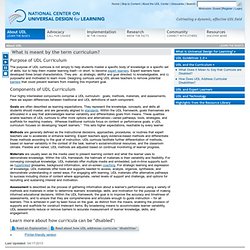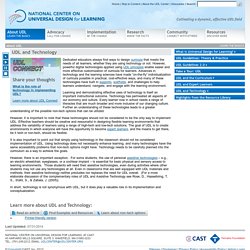

Transforming the process and outcomes of assistive technology research: Reflections on the use of participatory research methods with disabled university students. UDL and the Curriculum. Purpose of UDL Curriculum The purpose of UDL curricula is not simply to help students master a specific body of knowledge or a specific set of skills, but to help them master learning itself—in short, to become expert learners.

Expert learners have developed three broad characteristics. They are: a) strategic, skillful and goal directed; b) knowledgeable, and c) purposeful and motivated to learn more. Designing curricula using UDL allows teachers to remove potential barriers that could prevent learners from meeting this important goal. UDL and Technology. Dedicated educators always find ways to design curricula that meets the needs of all learners, whether they are using technology or not.

However, powerful digital technologies applied using UDL principles enable easier and more effective customization of curricula for learners. Advances in technology and the learning sciences have made “on-the-fly” individualization of curricula possible in practical, cost-effective ways, and many of these technologies have built in supports, scaffolds, and challenges to help learners understand, navigate, and engage with the learning environment.
Learning and demonstrating effective uses of technology is itself an important instructional outcome. Technology has permeated all aspects of our economy and culture. Every learner now in school needs a range of literacies that are much broader and more inclusive of our changing culture. UDL Guidelines 2.0. The goal of education in the 21st century is not simply the mastery of content knowledge or use of new technologies.

It is the mastery of the learning process. Education should help turn novice learners into expert learners—individuals who want to learn, who know how to learn strategically, and who, in their own highly individual and flexible ways, are well prepared for a lifetime of learning. Universal Design for Learning (UDL) helps educators meet this goal by providing a framework for understanding how to create curricula that meets the needs of all learners from the start. The UDL Guidelines, an articulation of the UDL framework, can assist anyone who plans lessons/units of study or develops curricula (goals, methods, materials, and assessments) to reduce barriers, as well as optimize levels of challenge and support, to meet the needs of all learners from the start.
They can also help educators identify the barriers found in existing curricula.
Cginitive/Learning Challenges. Hearing Impairment. Vision Impariment. Head Injuries (TBI) Spinal Chord Injury. Mobility.